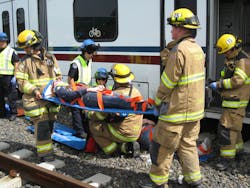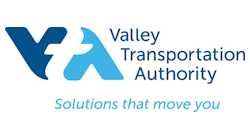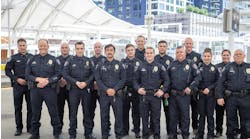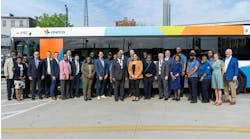The Santa Clara Valley (VTA) Transportation Authority operates both bus and light rail service. What is unique about the agency is that VTA operates through 15 different municipalities in the area, working with a number of different cities and regions. VTA also announced that it would be partnering with Bay Area Rapid Transit (BART) on the Silicon Valley project.
Having an extensive system means that VTA needs to take an innovative approach to preserving the security on the system.
“When we think specifically about our protective services team, the makeup might be unique [when looking at different cities.] Our protective services team is made up of three different groups,” explained Holly Perez, public information officer, VTA. “First and foremost we have a long-standing contract with the local Santa Clara County sheriff’s office. They are our, in essence, our transit patrol and they provide 24/7 law enforcement. The second part of that is private security provided by Allied Universal, so we work closely with the private security team. The third part of our protective services is our VTA employees and fare inspectors.”
Each of the three service teams have different areas of focus.
“Whenever there is an emergency security incident, criminal activity or security threat, it is really the sheriff’s office that we contract with that takes the lead,” explained Perez.
Alerting When Assistance is Needed
When an operator is faced with a threat on the bus or light rail line they reach out to VTA. “An operator would connect with our Operations Control Center. From there, the OCC connects directly with our transit patrol and a deputy is dispatched as needed,” said Perez.
When it comes to keeping their riders informed when there is a threat, VTA also turns to the use of technology.
“From a standpoint of how we might send out a mass notification out to riders, we have a number of different channels that we can deploy at any given movement. You of course have our VTA-managed social media channel and Facebook and Twitter. We have our VTA.org website. We do often use a platform subscription service, where if people want to be alerted, we have distribution lists that go to different areas.”
With the distribution lists, riders can sign up to receive specific information relating to different routes.
Perez added, “As for VTA, we use Govdelivery to communicate on a number of topics. For example, we might send out communications on service impacts, re-routing of buses, construction notices, and routine system checks after earthquakes. It’s a small sampling of how we can take advantage of this service.”
Responding to a Threat
The first step in VTA’s response to a threat or a security situation begins with training.
“Every security situation is so different. With our protective services team, the training starts before an incident happens. Our protective services team goes through different extensive training all through the year, whether that is crisis intervention or being trained on active shooter scenarios. We really feel strongly that it starts with preparation before the incident happens.”
Perez added that the training and awareness doesn’t just extend to the protective services team. “We really encourage our employees that security is really a shared responsibility. We want employees to take part and if they see something, say something. We really want our employees to take part in noticing human trafficking and how to identify those potential scenarios, especially with our bus operators and light rail operators.”
Some of the daily situations that can escalate into a threat to operator safety is disputes over fares or if a vehicle on VTA’s system happens to be running late.
“Safety and security is our number one priority. We often encourage our front line employees to not engage and call for help. No one should put their well-being at risk,” said Perez. “We really try to encourage them to mitigate the situation and not get perturbed by those interactions with customers on our system.”
The security teams are in ongoing trainings.
“These are not just a moment in time for us so throughout the year. We do everything from canine training, to working with tactical teams, doing scenarios and digging into active shooter scenarios,” said Perez. “It is an ongoing process for us to be prepared for the situations as they occur.”
In 2016 Santa Clara hosted Super Bowl 50. “That was a huge coordinated effort with pulling in assets from all over the country,” explained Perez.
Future Expansion Needs for Security
With the upcoming partnership with BART, VTA will have to expand its security reach. Brandi Childress, media and public affairs manager for VTA is working with BART on the Silicon Valley project.
“We are preparing for 10 extra miles and two extra stations opening in Santa Clara county this year. We have already started to enhance the security contract so we will have additional sheriff and Allied personnel working in anticipation for the opening and already have enhanced their contracts.”




